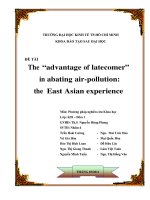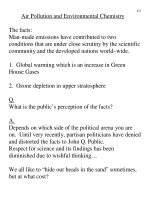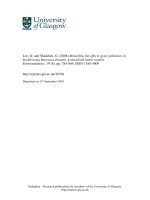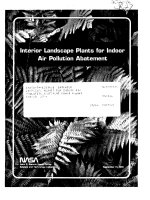Does traffic related air pollution cause childhood asthma
Bạn đang xem bản rút gọn của tài liệu. Xem và tải ngay bản đầy đủ của tài liệu tại đây (1.46 MB, 21 trang )
Session: New perspectives on vulnerable groups
Does traffic-related air pollution
cause childhood asthma?
Haneen Khreis1, Charlotte Kelly1,2, James Tate1, Roger Parslow3 and Karen Lucas1
1 Institute for Transport Studies, 2 Leeds Institute of Health Sciences, 3 Leeds Institute of Cardiovascular and Metabolic Medicine, University of Leeds
st
Changing Perspectives: 1 International Conference on Transport and Health, London, 6
– 8 July 2015
50 years of asthma: UK trends from 1955 to 2004
Trends in the prevalence of a diagnosis of asthma ever in children. m, month; y, year. Source: Anderson et al. (2007)
Why such steady and rapid increases?
“… the increase in disease must be
attributable to a change in as-yet unknown
environmental factors… ”
(Cookson, 2004, p. 979)
Source: Brook (2012)
Provide data
Systematic review
Does children’s exposure to traffic-related
Meta-analysis
air pollution increase their risks of
developing asthma?
Learn and apply lessons
Case study - The Born in Bradford
Khreis et al. (2014). Exposure to traffic-related air pollution and the development of childhood asthma. PROSPERO 2014:CRD42014015448, available from: />
3. Include studies which investigate children’s exposure to traffic-related air pollution only
1. Include human studies only 2. and
children’s studies only
4. Include studies which investigate exposure to traffic-related air pollution or traffic-related air
pollutants when road traffic is specified as their source
Does children’s exposure to traffic-related air pollution increase their risks
of developing asthma?
5. Include studies which report measures of
6. Include studies which specifically investigate the subsequent risk of
association and their confidence interval
asthma development in childhood
precision
7. Include observational studies only
Screening process
Research gaps and impact on validity: asthma definitions
•
•
•
•
Heterogeneous disease
No universally accepted definition
Has many phenotypes
AND non-specific symptoms….
Research gaps and impact on validity: asthma definitions
Self-report of doctor-diagnosis = 12.0%
Prescription registry = 32.2%
Source: Hansen et al. (2012)
Hospitalization registry = 6.6%
Research gaps and impact on validity: asthma definitions
Self-report of doctor-diagnosis = 12.0%
12
Prescription registry = 32.2%
1
Source: Hansen et al. (2012)
Hospitalization registry = 6.6%
Fay D, Tate J, Khreis H (2015): Investigating pedestrians PNC exposures in urban micro-environments near a busy road traffic intersection
B a ckg r o u n d S i t e
I n t e r s e ct i o n C o r n e r
R o a d C ro s s in g
I n t e r s e ct i o n C o r n e r
R o a d C ro s s in g
In t e r s e ct io n C o r n e r
B u s St o p
R o a d C ro s s in g
B u s St o p
I n t e r s e ct i o n C o r n e r
B a ckg r o u n d S it e
Research gaps and impact on validity: exposure models
Fay D, Tate J, Khreis H (2015): Investigating pedestrians PNC exposures in urban micro-environments near a busy road traffic intersection
B a ckg r o u n d S i t e
I n t e r s e ct i o n C o r n e r
R o a d C ro s s in g
I n t e r s e ct i o n C o r n e r
R o a d C ro s s in g
In t e r s e ct io n C o r n e r
B u s St o p
R o a d C ro s s in g
B u s St o p
I n t e r s e ct i o n C o r n e r
B a ckg r o u n d S it e
Research gaps and impact on validity: exposure models
Research gaps and impact on validity: exposure models
Proximity to roadways
Regulatory monitoring
stations
Land-use regression
models
Dispersion models
Research gaps and impact on validity: exposure models
10 studies reporting 30 risk
4 studies reporting 28 risk
estimates, 53% were positive
estimates, 93% were positive
(31% significant)
(65% significant)
10 studies reporting 55 risk
estimates, 93% were positive
(29% significant)
4 studies reporting 40 risk
estimates, 50% were positive
(35% significant)
23 studies, 153 main risk estimates from 4 exposure models, 114 (75%)
positive, 45 (39%) statistically significant… and more from the other
exposure models…
2
1
3
3
1
5
3
1
3
1
So does traffic-related air pollution cause asthma?
“The results found across the studies followed a
pattern that would be expected under the
plausible assumption that the pollutants really
are causally associated with asthma
development, if only among a subset of
children…”
(HEI, 2010,
p.363)
But…
Which pollutant(s)…
But…
… and why this heterogeneity?
Implications
• Traffic-related air pollution might have contributed to the recent
asthma epidemic
• Effect estimates are very likely to have been distorted/
underestimated
• Many effects were detected in areas meeting the relevant air
quality guidelines
• Black Carbon (and ultra-fine particles) are yet unregulated
Implications
• Traffic-related air pollution is a modifiable environmental factor
• Black Carbon (and ultra-fine particles) are truly traffic-related
pollutants
• -28% / -40% decreases in Black Carbon in the Milan congestion
charging area
(Mattioli, 2014)
• A substantial proportion of asthma cases can be prevented?
Thank you!
References
•
•
•
•
Anderson, H. R., Gupta, R., Strachan, D. P., & Limb, E. S. (2007). 50 years of asthma: UK trends from 1955 to 2004. Thorax, 62(1), 85-90.
•
•
Health Effects Institute, H. E. I. (2010) Traffic-related air pollution: a critical review of the literature on emissions, exposure, and health effects, Health Effects Institute.
•
Mattioli, G. (2015). Pollution or congestion charging? Air quality measures and road pricing in Milan, Italy, in Institute for Transport Studies Research Seminar Series,
University of Leeds, 05 March 2015.
Brook, J. R. (2012) 'Estimating exposure to traffic-related air pollution', in Health Effects Institute Annual Conference, Chicago, Illinois, 15-17th April 2012.
Cookson, W. (2004). The immunogenetics of asthma and eczema: a new focus on the epithelium. Nature Reviews Immunology, 4(12), 978-988.
Hansen, S., Strom, M., Maslova, E., Mortensen, E. L., Granstrom, C., & Olsen, S. F. (2012). A comparison of three methods to measure asthma in epidemiologic studies:
results from the Danish National Birth Cohort. PloS one, 7(5), e36328.
Khreis H, Kelly C, Tate J, Parslow R (2014). Exposure to traffic-related air pollution and the development of childhood asthma. PROSPERO :CRD42014015448, available
from: />









